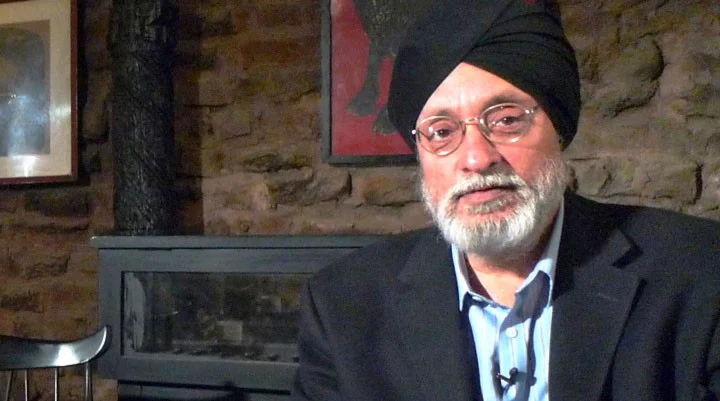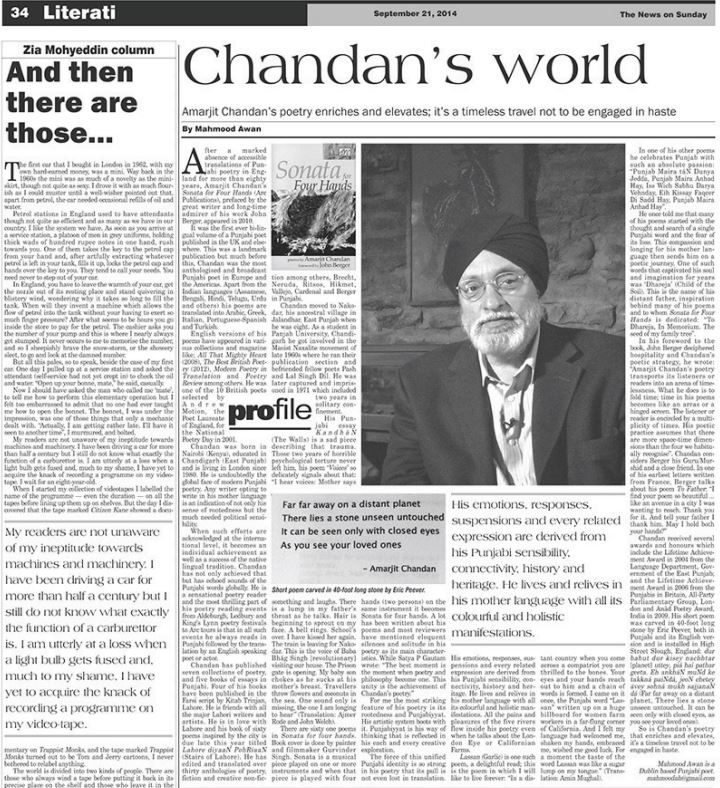Mahmood Awan (The News on Sunday, 8th December 2013)
After a marked absence of accessible translations of Punjabi poetry in England for more than eighty years, Amarjit Chandan’s Sonata for Four Hands (Arc Publications), prefaced by the great writer and long-time admirer of his work John Berger, appeared in 2010.
It was the first ever bi-lingual volume of a Punjabi poet published in the UK and elsewhere. This was a landmark publication but much before this, Chandan was the most anthologised and broadcast Punjabi poet in Europe and the Americas. Apart from the Indian languages (Assamese, Bengali, Hindi, Telugu, Urdu and others) his poems are translated into Arabic, Greek, Italian, Portuguese-Spanish and Turkish.
English versions of his poems have appeared in various collections and magazine like; All That Mighty Heart (2008), The Best British Poetry (2012), Modern Poetry in Translation and Poetry Review among others. He was one of the 10 British poets selected by Andrew Motion, the Poet Laureate of England, for the National Poetry Day in 2001.
Chandan was born in Nairobi (Kenya), educated in Chandigarh (East Punjab) and is living in London since 1980. He is undoubtedly the global face of modern Punjabi poetry. Any writer opting to write in his mother language is an indication of not only his sense of rootedness but the much needed political sensibility.
When such efforts are acknowledged at the international level, it becomes an individual achievement as well as a success of the native lingual tradition. Chandan has not only achieved that but has echoed sounds of the Punjabi words globally. He is a sensational poetry reader and the most thrilling part of his poetry reading events from Aldeburgh, Ledbury and King’s Lynn poetry festivals to Arc tours is that in all such events he always reads in Punjabi followed by the translation by an English speaking poet or actor.
Chandan has published seven collections of poetry, and five books of essays in Punjabi. Four of his books have been published in the Farsi script by Kitab Trinjan, Lahore. He is friends with all the major Lahori writers and artists. He is in love with Lahore and his book of sixty poems inspired by the city is due late this year titled Lahore diyaaN PohRiaaN (Stairs of Lahore). He has edited and translated over thirty anthologies of poetry, fiction and creative non-fiction among others, Brecht, Neruda, Ritsos, Hikmet, Vallejo, Cardenal and Berger in Punjabi.
Chandan moved to Nakodar, his ancestral village in Jalandhar, East Punjab when he was eight. As a student in Panjab University, Chandigarh he got involved in the Maoist Naxalite movement of late 1960s where he ran their publication section and befriended fellow poets Pash and Lal Singh Dil. He was later captured and imprisoned in 1971 which included two years in solitary confinement.
His Punjabi essay KandhãN (The Walls) is a sad piece describing that trauma. Those two years of horrible psychological torture never left him, his poem ‘Voices’ so delicately signals about that: “I hear voices: Mother says something and laughs. There is a lump in my father’s throat as he talks. Hair is beginning to sprout on my face. A bell rings. School’s over. I have kissed her again. The train is leaving for Nakodar. This is the voice of Baba Bhãg Singh [revolutionary] visiting our house. The Prison gate is opening. My baby son chokes as he sucks at his mother’s breast. Travellers throw flowers and coconuts in the sea. One sound only is missing, the one I am longing to hear“ (Translation: Ajmer Rode and John Welch).
There are sixty one poems in Sonata for four hands. Book cover is done by painter and filmmaker Gurvinder Singh. Sonata is a musical piece played on one or more instruments and when that piece is played with four hands (two persons) on the same instrument it becomes Sonata for four hands. A lot has been written about his poems and most reviewers have mentioned eloquent silences and solitude in his poetry as its main characteristics. While Satya P Gautam wrote: “The best moment is the moment when poetry and philosophy become one. This unity is the achievement of Chandan’s poetry.”
For me the most striking feature of his poetry is its rootedness and Punjabiyyat. His artistic system boots with it. Punjabiyyat is his way of thinking that is reflected in his each and every creative exploration.
The force of this unified Punjabi identity is so strong in his poetry that its pull is not even lost in translation. His emotions, responses, suspensions and every related expression are derived from his Punjabi sensibility, connectivity, history and heritage. He lives and relives in his mother language with all its colourful and holistic manifestations. All the pains and pleasures of the five rivers flow inside his poetry even when he talks about the London Eye or Californian Farms.
Lassan (Garlic) is one such poem, a delightful read; this is the poem in which I will like to live forever: “In a distant country when you come across a compatriot you are thrilled to the bones. Your eyes and your hands reach out to him and a chain of words is formed. I came on it once, the Punjabi word “Lassan” written up on a huge billboard for women farm workers in a far-flung corner of California. And I felt my language had welcomed me, shaken my hands, embraced me, wished me good luck. For a moment the taste of the word Lassan was like a sugar lump on my tongue.” (Translation: Amin Mughal).
In one of his other poems he celebrates Punjab with such an absolute passion: “Punjab Maira tãN Dunya Jedda, Punjab Maira Anhad Hay, Iss Wich Sabhu Darya Vehnday, Eih Kissay Faqeer Di Sadd Hay, Punjab Maira Anhad Hay”.
He once told me that many of his poems started with the thought and search of a single Punjabi word and the fear of its loss. This compassion and longing for his mother language then sends him on a poetic journey. One of such words that captivated his soul and imagination for years was ‘Dhareja’ (Child of the Soil). This is the name of his distant father, inspiration behind many of his poems and to whom Sonata for Four Hands is dedicated: “To Dhareja, In Memorium. The seed of my family tree”.
In his foreword to the book, John Berger deciphered hospitality and Chandan’s poetic strategy, he wrote: “Amarjit Chandan’s poetry transports its listeners or readers into an arena of timelessness. What he does is to fold time; time in his poems becomes like an arras or a hinged screen. The listener or reader is encircled by a multiplicity of times. His poetic practice assumes that there are more space-time dimensions than the four we habitually recognise”. Chandan considers Berger his Guru/Murshid and a close friend. In one of his earliest letters written from France, Berger talks about his poem To Father: “I find your poem so beautiful … like an avenue in a city I was wanting to reach. Thank you for it. And tell your father I thank him. May I hold both your hands?”
Chandan received several awards and honours which include the Lifetime Achievement Award in 2004 from the Language Department, Government of the East Punjab; and the Lifetime Achievement Award in 2006 from the Punjabis in Britain, All-Party Parliamentary Group, London and Anãd Poetry Award, India in 2009. His short poem was carved in 40-foot long stone by Eric Peever, both in Punjabi and its English version and is installed in High Street Slough, England: dur bahut dur kisey nachhtar [planet] uttey, piá hai pathar geeta. Eh ankháN muNd ke takkná paiNdá, jeoN chetey ávey sohná mukh sajjanaN dá (Far far away on a distant planet, There lies a stone unseen untouched. It can be seen only with closed eyes, as you see your loved ones).
So is Chandan’s poetry that enriches and elevates, it’s a timeless travel not to be engaged in haste.
Published on 8th December 2013 in The News on Sunday.
https://www.thenews.com.pk/tns/detail/557105-amarjit-chandans-world


